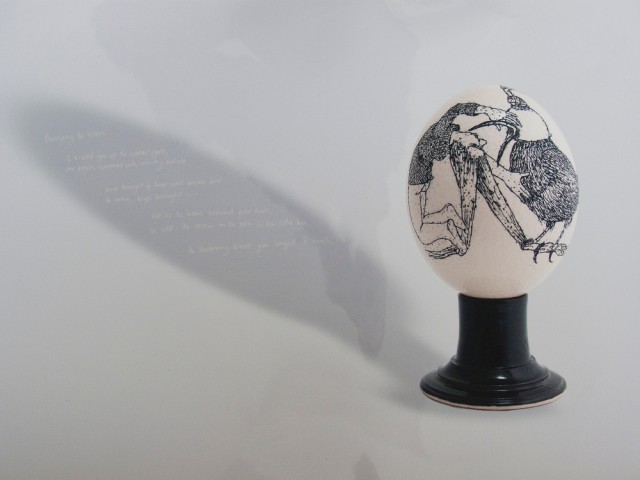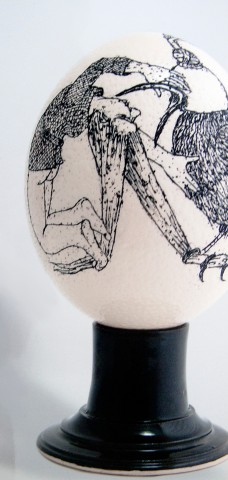The Wren's Egg by Deryn Rees-Jones and Alice Maher
The first thing we see in this collaboration of Deryn Rees-Jones and Alice Maher, a poem-photograph entitled The Wren’s Egg, is a very large egg with an ink drawing upon its surface. And then if we linger a while, we see the long cast shadow and very faintly, the lines of the poetic text. It is a short poem, only seven lines, and reads as follows:
BURYING THE WREN
I kissed you at the corner gate,
our breath warmed with whisky and ale
and thought of that shy brown bird
the wren boys brought:
soft as the hairs behind your ears –
so cold – the wren on the pole in her little box –
the fluttering breast you longed to touch.
Deryn goes on to speak about the background of the poem:
I first came across the story of the Wren Boys in the Museum of Country Life, in Mayo, where for many Easters and summers I used to holiday with my husband and young family. The wren boys are mummers of sorts. On the 26th December, wearing old clothes or straw suits, and wearing masks or with cork-blackened faces, they move from house to house carrying a pole tied with holly and ribbons, on the top of which is a little basket or box. Inside, supposedly, is a wren. A real bird? A dead bird? Any bird at all? This little bird carried a huge charge for me, in part because of my own identification with birds (my name is derived from the generic Welsh term for a little bird) and because of a wider sense of the role birds play as intermediaries between the living and the dead. The Wren Boys then sing a song, of which there are many variations, which goes along the lines of the following:
The wren, the wren, the king of all birds,
On St. Stephen's Day was caught in the furze,
Although he is little, his family is great,
I pray you, good landlady, give us a treat.
My box would speak, if it had but a tongue,
And two or three shillings, would do it not wrong,
Sing holly, sing ivy – sing ivy, sing holly,
A drop just to drink, it would drown melancholy.
And if you draw it of the best,
I hope in heaven your soul will rest;
But if you draw it of the small,
It won't agree with these wren boys at all.
It was not until much later that I found out that this is not simply an Irish tradition, but is one which occurs in Wales as well.
This is the historical reference of the Wren boys. As a beginning point for reflection, she goes on to discuss the part of the motivation behind the writing:
I wanted to set up a dynamic between the bird and the woman in the poem. Whose fluttering breast is being touched, the bird’s or the woman’s? Who is cold? Who wants to touch who or what? There’ s also a funny sort of mixing and mingling between the I and the He and the bird. I cut the poem right back from a fourteen line poem to this seven lines, taking out the specific details of the story of its characters. In some ways I think of it as a half sonnet. In the service of its design it is without its second part; perhaps it is the equivalent of a piece of paper folding.
If I think of ‘Burying the Wren’ as a poem which, little piece of origami that I have now made it, is in turn a little box, I like to think too that I am setting it up as a version of Shroedinger’s cat, the thought experiment devised by the physicist Erwin Shroedinger in the 1930s to illustrate an aspect of quantum theory called superposition. In this famous experiment an imaginary cat is placed in an imaginary box with an imaginary radioactive atom and some prussic acid. If even a small amount of the atomic matter decays then a hammer will be released, shattering the bottle in which the poison is kept, thus killing the cat. The theory of superposition suggests that since we really cannot know without opening the box, whether the cat is alive or dead, that the cat exists in a state of simultaneous aliveness and deadness. It is the observation of the cat that affects the outcome: it is only when we open the box that we can know one way or another.
In response to this complex of associations, references and ideas, Alice Maher is drawn to the deep enigma of imagining eggs as ideal containers of the invisible, standing for the whole bird, for all birds, for potentiality itself. And on the surface, in the manner of Greek Attic vases, the line drawing depicts a large bird, nearly human size. Are they fighting, wrestling like ancient heroes? Is the bird about to swallow the figure, or the figure to wrench the bird’s neck? In its invisible contents, poised for eternity, the figures are posed in tension, in the visible unknowingness the artist and poet have given us.
Alice Maher was educated at the Crawford College Cork, University of Ulster, and San Francisco Art Institute. Her first major solo show in Ireland, ‘familiar’ was presented at the Douglas Hyde Gallery in 1994. Other shows since include: Sao Paolo Biennale, Brazil; Natural Artifice, Brighton and Hove Museum (2007); and many others in France, USA, Finland and Portugal. Currently she is showing at Purdy Hicks, London (Godchildren).
Deryn Rees-Jones' most recent poems are Falls & Finds (Shoestring, 2008). Seren has published three collections of her poems, including Signs Round a Dead Body (1998) and Quiver (2005). Her critical work includes a monograph on Carol Ann Duffy, and a book of essays Consorting with Angels>/i>. In 2010 she was given a Cholmondeley Award for achievement in poetry.




